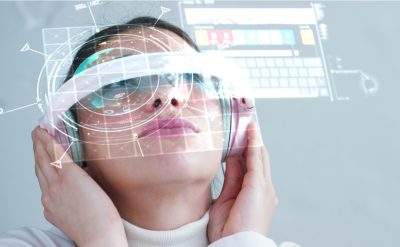Highlights:
- Augmented technology is the new future and will become the new interface between humans and machines.
- Companies are implementing AR into their pre-sales, point-of-sale, and after-sales processes as they realize its immense value.
We live in an era where customer experience is increasingly becoming crucial to a company’s success. It has become a vital component of Customer Relationship Management (CRM) as customers who have a positive experience about a product or service are likelier to become loyal customers. As a result, to meet customers’ fluctuating demands, firms need to be more adaptable, efficient, and nimble.
It is here that the business ecosystem has witnessed the introduction of game-changing technology, AR technology, that is redefining the consumer experience across industries. The focus point of AR is the interaction between the user and the virtual information registered in a 3-D space. Exchanges take place in real time, and the user’s actions influence the rendered virtual elements. Pioneering firms are using it for product development, manufacturing, marketing, logistics, and customer service and are witnessing significant quality and efficiency advantages.
AR technology has introduced new ways for brands to interact and is a big differentiator in today’s market. It’s predicted that augmented technology will become the new interface between humans and machines.
Market dynamics in today’s hyper-connected world have propelled businesses to seek out-of-the-box solutions to give the most immersive experiences to their customers. Banking on AR’s potential has been their best bet for them. AR is key to increasing sales and improving the organization’s customer experience.
The AR and VR market was valued at 26.7 billion USD in 2018 and is expected to expand at a compound annual growth rate (CAGR) of 63% to reach 814.7 billion USD by 2025.
Let’s look at how augmented reality technology can boost sales and business growth.
Enhances decision-making by eliminating indecision
Reaching a purchase decision is the most crucial step in a customer’s journey, especially when shopping online. Many consumers are reluctant to buy a product or service as they are unsure if it’s an apt fit. Here, AR technology infuses confidence by allowing clients to test a product or service in their homes before they make a purchase. In addition, it helps build brand credibility and customer confidence in the online buying experience. This boosts the frequency with which customers visit online retailers, converting them immediately into potential customers and maximizing revenues.
According to Statista, by 2023, global shipments of AR headsets will exceed 30 million units, nearly 12 times the amount expected to be sold in 2020.
AR-based training
AR is proving to be a crucial technology that helps in the transfer of knowledge and requires less specialist expertise as well. Creating a repository of AR training resources, which can be utilized as teaching aids or an immersive reference library, can harness the expertise of experienced employees. Training with AR can enable personnel to be field-ready in less than half the time it takes with traditional methods. In addition, it decreases the likelihood of expensive errors and contributes to the cost-effectiveness and affordability of training.
A well-trained and knowledgeable team can significantly contribute to the enhancement of customer satisfaction and experience.
Adding value to interactive packaging
Top corporations such as Coca-Cola, Lucozade, McDonald’s, Absolut, and Heinz utilize interactive AR packaging to get a better visual experience of a product’s packaging. Apple and Google offer supporting software platforms, ARKit and ARCore, respectively, making it convenient for developers to build AR content for smartphones.
In fact, there are multiple benefits: Enhanced product packaging, improved brand loyalty, new customers, and much more. AR technology also helps cut competition as customers interact more with the product or service and have a more rewarding experience resulting from 3D images.
How to integrate augmented reality into your business?
Now that the benefits of AR technology in influencing customer decisions have been established, a common question may arise: How is AR in business brought into practice? Here is the roadmap to follow:
- Do market research: It’s human nature to move with the flow, but when it comes to AR in businesses, one must do thorough market research about business objectives and business plans and grasp the potential of technology appropriately. Before investing in AR technology, it is essential to do an AR market and competition analysis. This helps gain an understanding of what AR may be used for, what the future holds, and how the technology has aided your competitors in establishing a distinct market image. Consequently, you can determine if the investment is worthwhile.
- Examine internal business challenges: In addition to researching how your competitors are earning money with AR adoption, it is vital to understand the constraints of your business processes. Explore the various business sectors and engage the relevant personnel to understand the difficulties they face. Later, discuss and conclude on how to leverage augmented reality in business.
Future of augmented reality in boosting sales and customer experience
Thanks to AR technology, sales and customer connections are experiencing an extraordinary revolution. Companies are implementing AR into their pre-sales, point-of-sale, and after-sales processes as they realize its immense value.
However, AR will have a market-altering effect in the near future. It will play a vital role in making customers feel appreciated, empowered, and unique. AR represents the future of corporate success.
It’s predicted that AR will have penetrated virtually every aspect of marketing by 2030. Organizations leveraging AR technology will gain a competitive advantage in an otherwise flooded market. Gradually, brands are realizing AR’s multiple benefits and incorporating them into their pre-sales, point-of-sale, and after-sales operations.
Going forward, AR for business will help companies understand how their customers interact with their business. It will help them enhance engagement and sales and help them analyze their marketing campaigns.


































































